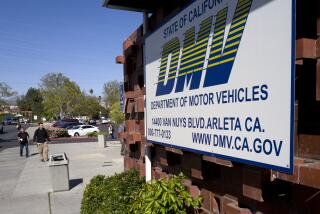Stricter Rules for Elderly Motorists Could Be Urged
Although the circumstances surrounding Wednesday’s traffic calamity at the Santa Monica Farmers’ Market remained under investigation, the fact that the driver who caused it was an octogenarian is likely to reinvigorate a debate that has raged for years: How old is too old to drive?
Police said early indications were that driver error led to the accident. They said 86-year-old George Russell Weller appeared confused and told investigators he may have stepped on the accelerator when he tried to hit the brake pedal.
“Anecdotally, we have heard cases where older drivers have made that sort of mistake,” said Patti Yanochko, who was the coordinator of a statewide task force on older adults and traffic safety.
Dr. Russ Kino, chief of the emergency room at St. John’s Health Center, where some of Wednesday’s victims were brought by ambulance, said: “The whole scenario is not that surprising to me. We see an alarming number of older drivers losing control.”
If age is determined to have been a factor in the crash, the accident is likely to renew calls for tighter regulations of elderly motorists.
That’s what happened after another Santa Monica accident in 1998, when a 96-year old driver struck and killed a 15-year-old girl. Then-state Sen. Tom Hayden (D-Los Angeles) pushed for a law requiring the Department of Motor Vehicles to road-test motorists 75 and older. But senior citizens groups vigorously opposed the idea. Ultimately, age was not mentioned in the law that established a minimum vision requirement for a driver’s license and imposed behind-the-wheel testing if doctors or others report concerns about a driver’s physical or mental limitations.
The DMV doesn’t disqualify elderly drivers from obtaining licenses, but it does require those older than 70 to renew them in person rather than by mail. Across the country, 19 states require older drivers -- typically those older than 65 or 70 -- to renew their licenses in person, to renew them more often or to pass road and vision tests, according to the Insurance Institute for Highway Safety.
Weller, the driver in Wednesday’s fatal crash, had passed vision and written tests in November 2000, but he was not asked to take a driver’s test, said Armando Botello, a DMV spokesman. “At the time, he showed no obvious signs or conditions that would have caused us to have him take the driving test,” he said.
According to several studies, drivers older than 65 have very low accident rates and are not the threat to others on the road that many believe them to be. Those statistics, however, are skewed somewhat because older motorists tend to drive fewer miles, according to critics. When mileage is taken into account, the number of serious traffic accidents rises dramatically for drivers older than 70.
When older drivers do get into accidents, they are more easily hurt and less likely to survive their injuries, studies have shown.
“If you look at seniors as a group, they are not unsafe drivers,” said Arline Dillman, who handles safety issues for the Automobile Club of Southern California. “But as people age, they become more physically frail. If a senior is involved in a crash, they’re more likely to be killed or injured than a younger person in the same accident.”
In California, the aging of the baby boomer generation is expected to significantly increase the number of older motorists on the road in the next 10 to 15 years. As a response, officials from the DMV, the California Highway Patrol, the Department of Transportation and the Center for Injury Prevention, Policy and Practice have been grappling with recommendations to improve traffic safety as more and more elderly drivers remain on the road.
Several efforts are focused on helping seniors drive safely despite losses in vision, mobility and strength.
Howard Boyer, 67, teaches driver-safety courses sponsored by the seniors advocacy organization AARP in Huntington Beach and other parts of Orange County. His lessons, which include recommendations such as seniors should avoid making left turns and lane changes, may seem disconcerting to some.
“Because of loss of depth perception and peripheral vision, seniors cannot gauge the oncoming cars,” Boyer said. “Unsafe lane changes cause 35% of senior citations, and 25% of senior violations are from unsafe left turns.”
One chapter in the organization’s driving handbook focuses on the question of whether it’s time to quit driving, Boyer said.
“Self-evaluation is the whole thing about it,” he said. “One of the key things is the guilt factor. We ask them, ‘How are you going to feel if you have an accident and something terrible happens? Are you going to say I wish I had stopped driving before this?’ ”
More to Read
Sign up for Essential California
The most important California stories and recommendations in your inbox every morning.
You may occasionally receive promotional content from the Los Angeles Times.









